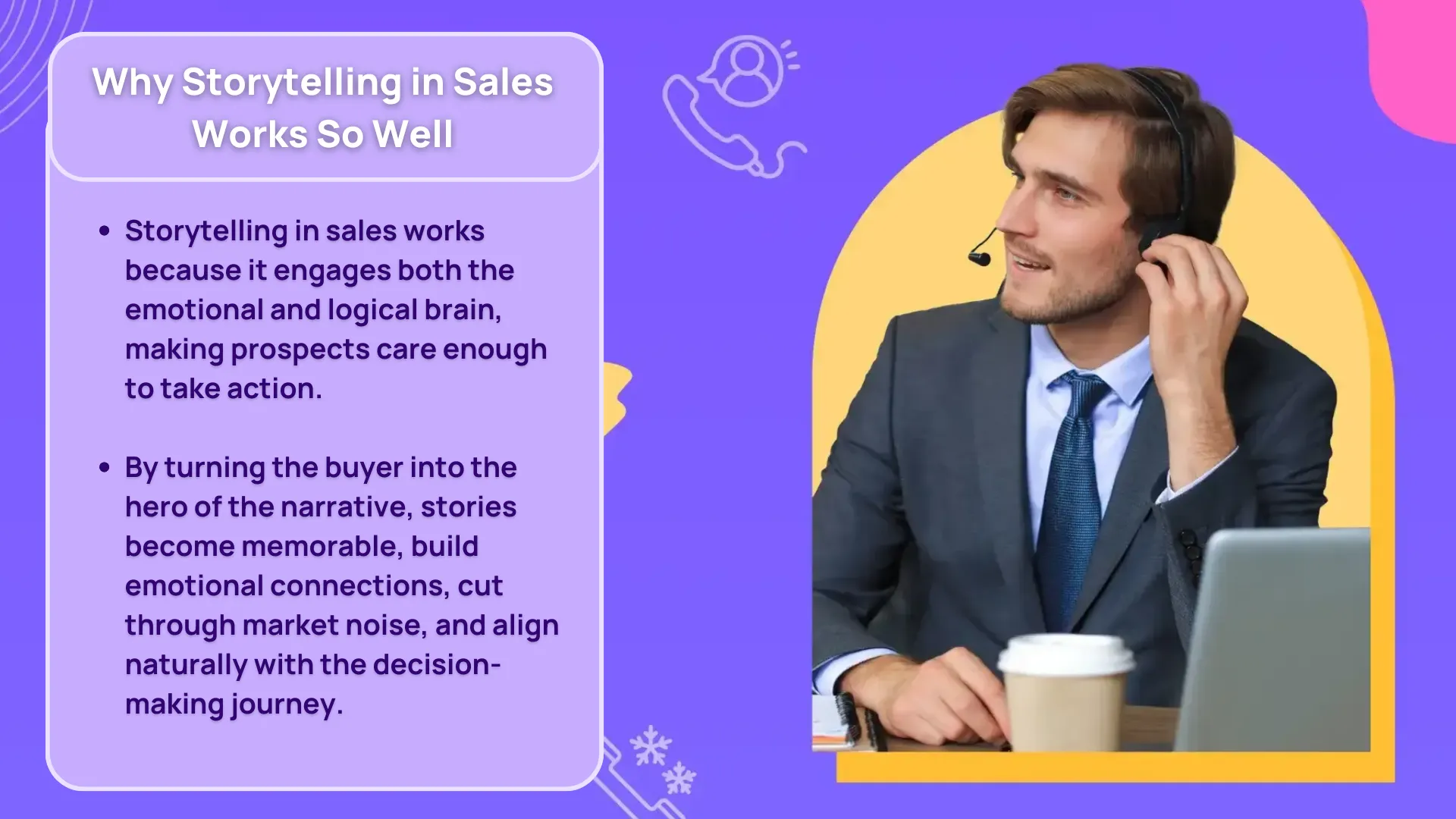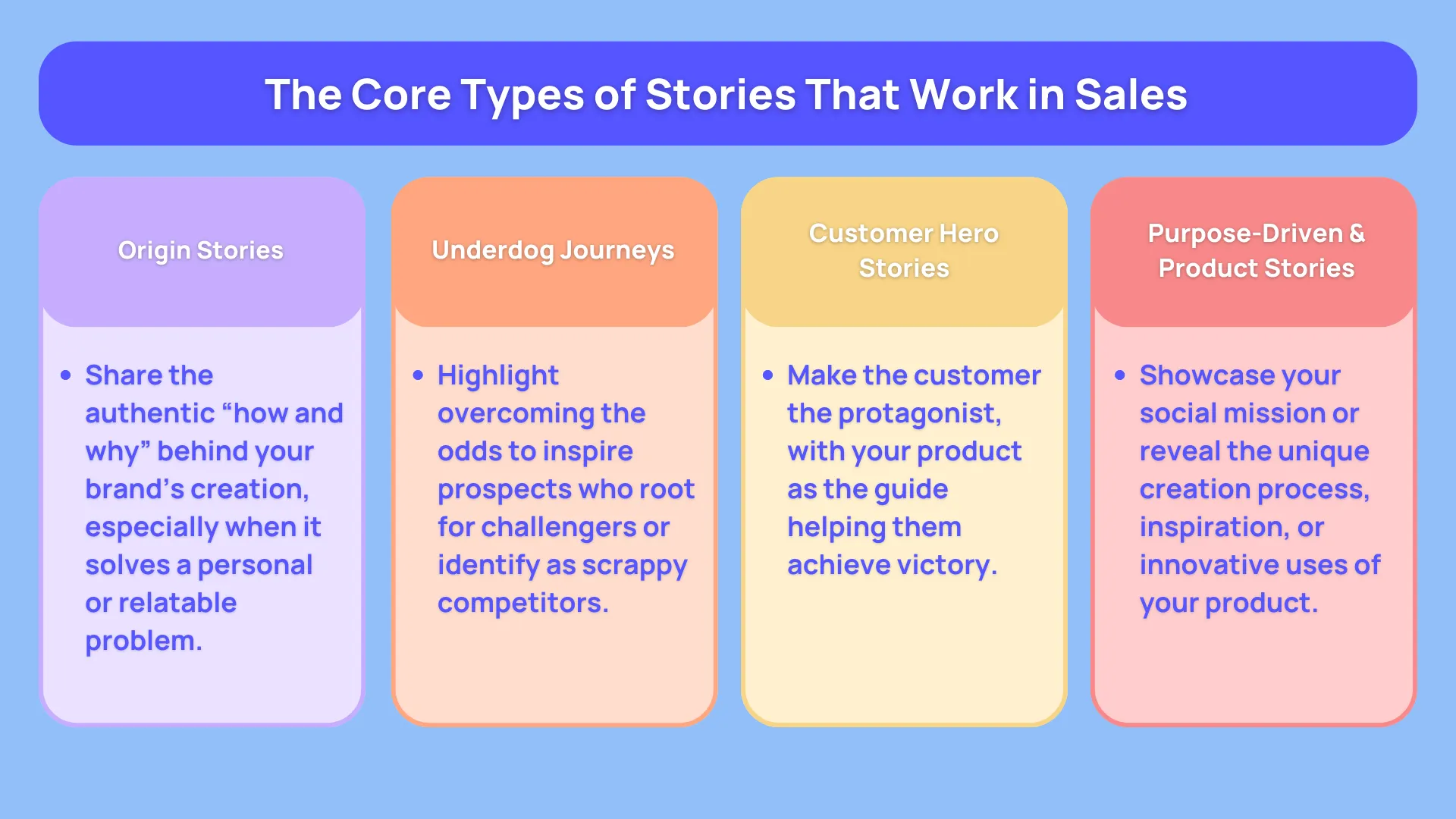
Our Top Picks


Storytelling in sales an age old pradtice.
Long before marketing campaigns, sales funnels, and conversion metrics, people were sitting around fires telling stories — and those stories had a way of sticking.
Our brains are wired to pay attention to narratives, to connect emotionally with characters, and to remember information when it’s presented as part of a journey rather than a dry list of facts.
Psychologist: Jerome Bruner found that we’re 22 times more likely to remember a fact when it’s wrapped in a story. Stanford’s Graduate School of Business ran a study comparing pitches filled with statistics versus those told as stories. The numbers were clear: only 5% remembered a statistic, but a striking 63% recalled the stories. That’s the power of narrative in action.
When you apply this same principle to sales, you unlock one of the most effective tools for influencing decisions. This is where sales storytelling comes in: using carefully structured, customer-focused narratives to make your message resonate deeply, inspire action, and keep your brand top of mind.
Why Storytelling in Sales Works So Well

When you’re selling, your job isn’t just to convey information. It’s to make the other person care enough to take the next step — to schedule the demo, sign the contract, or pull the trigger on that purchase.
Stories help you do that in a way raw data never can.
Stories stick because they trigger both emotional and logical parts of the brain. The logical brain processes the facts, but the emotional brain is what drives action. And in sales, action is everything.
When you craft a narrative around your product, your customer is no longer an outside observer. They step into the story, imagining themselves as the main character and visualizing the benefits in their own life. That’s why effective storytelling in sales tactics almost always leads to stronger engagement and better conversion rates.
Here’s why it works so consistently:
- Stories are inherently memorable – People forget bullet points; they remember characters, challenges, and resolutions.
- They build emotional connection in sales – Human beings are hardwired to connect with emotions before they rationalize with facts.
- They cut through information overload – In a crowded market, a compelling story stands out more than a feature list ever could.
- They align with the buyer journey storytelling approach – A well-told sales story mirrors the stages of a prospect’s decision-making process.
The Core Types of Stories That Work in Sales

Before you start crafting your narrative, it helps to know the common story types used in storyselling techniques. Each one taps into a different emotional driver and serves a different purpose in the sales process.
Origin Stories
These tell the “how we started and why” journey of your brand.
They work best when they’re authentic and customer-focused. For example, if your company was founded to solve a problem you personally struggled with, that instantly makes the pitch relatable. Think of Patagonia’s commitment to the environment or Ben & Jerry’s focus on social values.
Underdog Journeys
Everyone loves rooting for the one who overcomes the odds. This is a great sales narrative structure if you’re a challenger brand taking on industry giants or if your customer base sees themselves as scrappy go-getters.
Customer Hero Journeys
Instead of making your company the hero, you position your customer as the central figure. The challenge they faced becomes the inciting event, your product is the guide, and the victory is theirs. This form of buyer journey storytelling is especially powerful because it’s entirely customer-centric.
Social Mission Stories
When your brand stands for something beyond profit — environmental causes, social justice, community development — telling that story can forge an authentic brand storytelling connection that’s hard to beat.
Product Journeys
These pull back the curtain on how your product is made, the inspiration behind it, or unique ways people are using it. This is a great approach for brands with craftsmanship, innovation, or exclusivity at their core.
The Science Behind a Sales Story That Converts
All stories share a few structural elements that make them effective. In pitch storytelling frameworks, this typically means a beginning, middle, and end — but each of those stages has a very specific role in sales.
- The Beginning is where you grab attention and set up the stakes. In sales, this often means highlighting a relatable problem your audience faces.
- The Middle is where tension builds. You outline the challenges, show failed attempts, and make the prospect feel the urgency of solving the problem.
- The End is your resolution. Here you introduce your product or service as the path to success, often supported by proof in the form of case studies or testimonials.
This sales narrative structure works because it mirrors how people naturally process experiences: they orient themselves, they encounter a challenge, and they seek resolution.
Crafting a Customer-Centric Narrative
A customer-centric narrative flips the traditional sales pitch on its head. Instead of focusing on what you sell, you focus on who you’re selling to. That means understanding their pain points, goals, values, and even their language.
Start by asking:
- Who exactly am I speaking to?
- What challenges keep them up at night?
- What outcome would make them feel like they’ve won?
Once you know this, you can position your customer as the protagonist, your product as the guide, and the purchase as the moment they achieve their victory. This approach turns a generic pitch into an authentic brand storytelling experience that feels personal.
Storyselling Techniques That Close Deals

Storyselling techniques are about blending persuasive storytelling and emotional content in sales with clear or subtle calls to action.
The latter depends on the nature of the call, and we’d strongly recommend that you practice the skill enough times to realize how the calls go, and wherever it needs to be steered.
From a broader perspective, iIt’s not just telling a good tale — it’s telling one that naturally leads the listener toward buying.
A few proven techniques include:
- Contrast storytelling – Paint the “before” scenario in vivid detail, then show the “after” transformation your solution delivers.
- Case study storytelling – Use real customer wins as your narrative backbone. This not only builds trust but also provides social proof.
- Sensory detail – Use language that makes the listener feel like they’re experiencing the situation, from sights and sounds to emotions.
- Micro-stories in conversation – Instead of one long pitch, weave smaller, relatable anecdotes into your interactions.
When used well, these techniques feel conversational rather than scripted, which is key for building trust.
Emotional Connection in Sales
An emotional connection is the difference between someone nodding politely and someone leaning in, ready to commit.
Several studies show that buyers are far more likely to purchase from a brand they feel emotionally connected to, even if it costs more.
Persuasive storytelling in sales taps into emotions like hope, relief, pride, or even fear of missing out. The goal is not to manipulate, but to connect in a way that feels genuine and value-driven. This is where value-driven sales conversations come in — you’re not just selling a product, you’re offering a meaningful change in the customer’s life or business.
Building Your Pitch Storytelling Framework
A pitch storytelling framework gives you a repeatable process for turning any sales conversation into a compelling narrative. Here’s one you can adapt:
- Hook – Start with a relatable challenge or surprising fact.
- Relate – Show that you understand the prospect’s situation.
- Challenge – Highlight the stakes of not solving the problem.
- Guide – Introduce your solution as the trusted path forward.
- Prove – Share relevant case study storytelling or testimonials.
- Invite – End with a clear, actionable next step.
As a manager in charge of a sales team or a group of outbound cold callers, you need to ensure that their pitch feels natural while still steering the conversation toward a decision.
Even when everything’s done right, sometimes the leads aren’t “into it.” And that’s okay.
Sometimes, there are gatekeepers who play a vital role in escalating a sales conversion process, while there are moments when prospects aren’t converting. It’s a naturally occurring process where conversions could be low. But keep at it with a consistent approach, and you’ll eventually see the results trickle in.
Create Case Study Storytelling To Further Build Credibility
Case studies are one of the most effective forms of persuasive storytelling in sales because they’re grounded in real-world proof. When a prospect hears how someone in a similar situation achieved success using your product, it eliminates a huge amount of uncertainty.
If you happen to be a cold caller, you can talk about how your prospects’ competitor recently opted for your company’s services, and/or products, and improved their results by so and so percentage. However, it needs to be done via a data backed approach, so that whenever your potential clients double down on background checks, everything seems in order.
Moving on, the key to making case studies work as stories is to humanize them.
Instead of listing KPIs and results, talk about the people involved, the challenges they faced, the roadblocks they hit, and how your product helped them overcome each one.
Examples of Authentic Brand Storytelling in Action
Top-performing brands have been using storytelling in sales for years. They do so in a subtle manner, carefully crafting narratives and adding a human touch to bank on the emotional factor on prospects’ end.
It requires practice and a well timed marketing strategy.
Let’s look at a few examples and see what makes them work.
- Mailchimp – Through its “Bloom Season” docuseries, Mailchimp highlights the journeys of Black and LGBTQIA+ entrepreneurs, turning its brand into a champion of diverse voices. This is more than marketing — it’s a platform for customer success stories.
- Nike – The “Winning Isn’t Comfortable” campaign skips the glamour shots and shows the grind: early mornings, sore muscles, and moments of doubt. It connects with anyone who’s ever pushed themselves toward a goal.
- Guinness – Their Liberty Fields RFC campaign tells the true story of a Japanese women’s rugby team that defied societal norms. It’s a masterclass in tying brand values to an inspiring narrative.
- Manchester United – Their “Wake Up The Devil Inside You” mobile-first campaign merges football, Manga, and gaming to connect with Chinese fans in a culturally relevant way, making the story interactive and personal.
Value-Driven Sales Conversations Through Storytelling
When you combine authentic brand storytelling with a focus on delivering tangible value, you create conversations that are both memorable and motivating. In other words, it means you’re not just talking about features or pricing — you’re talking about outcomes, transformations, and the bigger picture.
A value-driven sales conversation framed as a story gives your audience something to hold onto emotionally and logically. It’s no longer about “buying software” or “hiring a service” — it’s about achieving a goal they care deeply about.
How to Use Storytelling to Influence Sales Decisions
If you’re asking yourself, how can I use storytelling to enhance my sales pitch, the answer lies in making your prospect the center of the narrative and aligning your solution with their personal or business aspirations.
That means:
- Choosing story types that match their stage in the buyer journey storytelling process.
- Using emotional triggers that resonate with their values.
- Supporting every claim with proof through case studies or real-life examples.
Over time, through rigorous practice, storytelling doesn’t just enhance a pitch — it becomes the reason the pitch succeeds. Rinse and repeat so that storytelling in sales becomes more of a second nature.
Sales Storytelling Needs Consistent Effort
Effective sales tactics through storytelling aren’t just about telling interesting tales.
They’re about building a bridge between your customer’s challenges and your solution, in a way that feels authentic, valuable, and memorable.
Top performers know that when you master sales storytelling, you’re not competing on features or pricing alone — you’re competing on connection.
That being said, we have plenty of tools with built-in narratives and coaching features that sales callers and lead hunters use from time to time.
But, you also need to know that any digital solution, regardless of whether it’s got A.I. or not, is just a means to an end. Like any other sales conversion strategy, storytelling is also an art. It needs practice, alongside a PMA; positive middle attitude to help you develop connection easily.
All the best!
Frequently Asked Questions

1. How can I use storytelling to enhance my sales pitch during outbound calls?
When you’re making cold or warm calls day in and day out, the challenge is getting the other person to actually listen — and stay on the line long enough to care.
Storytelling changes the game here because it transforms your pitch from “just another sales call” into a conversation they can picture themselves in.
Instead of rattling off your product’s features, start with a short, relatable story about a customer who faced the same problem your prospect likely has. For example:
“I just spoke to a business owner last week who was struggling with the exact same slowdown you mentioned… They felt stuck, wondering if their team could handle another quarter like this. Then they tried [solution], and in less than 30 days, they were already seeing [result].”
That’s buyer journey storytelling in action — and it works because it’s about them, not you. The moment a prospect sees themselves in your story, they lean in instead of tuning out. That’s the heart of effective storytelling in sales tactics for outbound teams.
2. What’s the best sales narrative structure for a cold call?
Outbound sales calls are a race against time. You don’t have 10 minutes to set the scene; you’ve got seconds to earn interest. A tight sales narrative structure is key. For cold calls, think of it as a three-act play compressed into under two minutes:
- Hook fast – Start with a situation they instantly recognize.
- Relatable struggle – Share a quick customer-centric narrative showing the challenge.
- Positive outcome – End with the resolution your solution provided, and invite them to explore it for themselves.
It’s essentially pitch storytelling framework on fast-forward. The emotional connection in sales still happens, but you’re delivering it in a way that respects their time and keeps them curious.
3. Can storytelling really influence sales decisions in an outbound setting?
As a matter of fact, it can!
Especially when you understand that most decisions aren’t purely logical, storytelling in outbound sales helps to a certain extentn.
In outbound sales, you or your team are often “interrupting” someone’s day because of the whole cold call thing. Facts alone might earn polite interest, but emotions drive the decision to continue the conversation or book a meeting.
If you were to use storyselling techniques and build an authentic brand storytelling moment right there on the call, you would end up creating a shift in how the prospect sees the conversation. You’re no longer “the salesperson who called me out of nowhere” — you become “the person who told me about that business just like mine that turned things around.”
That’s the real power of how to use storytelling to influence sales decisions in outbound work: making your call feel less like a transaction and more like the start of a relationship.
4. How do I make my outbound sales storytelling more customer-centric?
A customer-centric narrative starts with knowing your audience inside out. In outbound sales, that means researching their industry, understanding their likely challenges, and listening more than you talk during the first few seconds of the call.
Once you’ve heard their pain points, frame your story so they’re the hero. For example:
- Instead of “We help companies like yours increase lead conversion by 30%,” try “A sales manager I spoke with last month was frustrated that 7 out of 10 leads were slipping away. After trying [solution], they saw conversions climb 30% — and it completely changed their quarter.”
This style keeps the focus on them, which is essential in value-driven sales conversations. The more your prospect feels the story belongs to them, the more likely they are to engage.
5. What role do case study stories play in outbound sales?
Cold and warm calls can feel high-pressure because you’ve got to earn trust quickly. Case study storytelling is one of the fastest trust-builders available.
When you share a real-world example of a customer in a similar situation, you’re showing proof without making it sound like a hard sell. It works especially well when the story feels spontaneous and conversational — like you’re recalling it naturally, not reading from a script.
The key is to keep it short enough for a call but rich enough in detail to feel authentic:
“One of our clients, a small logistics company in Ohio, was losing repeat customers because their delivery updates were delayed. We set them up with [solution], and within two weeks, they had real-time tracking and a 15% increase in customer retention.”
That’s proof, credibility, and relatability all rolled into one — a perfect example of persuasive storytelling in sales.






